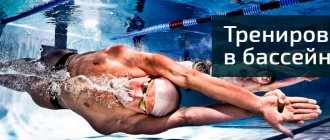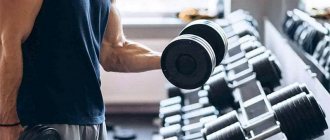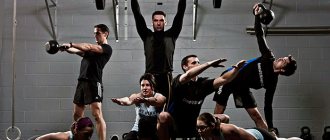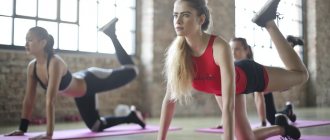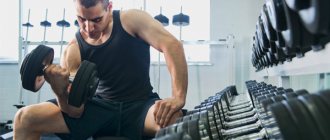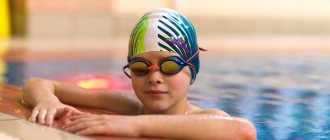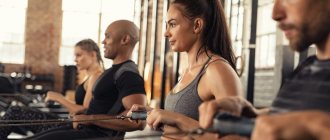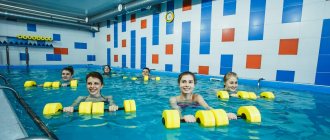Fitness classes require a certain load, after which you need to rest and relax, because during the training process a strong load was placed on the muscle fibers. Since many people now visit a fitness club, the question arises: is it possible to go to the pool after training, and how to combine it?
Many experts believe that such a “duet” of training will make the body visually better and tighten it. But it’s better to resolve the issue with the coach. Swimming is a great relaxing way to focus on the technical aspects of your workout. This is very important for the body, because during strength training muscles develop, flexibility increases, and it would be good to consolidate all this to get good results and speed up the recovery process.
Swimming is considered an aerobic form of exercise, which promotes excellent muscle development and brings it to perfection - the muscles acquire a toned and high-quality appearance. In addition, if you compare energy costs, it is in the leading place, ahead of running and an exercise bike. Therefore, such aerobic training will be a wonderful addition to the hard work with weights in the gym.
Is it possible to use the pool at the same time as the gym?
More often, going to the gym has a decorative purpose - to obtain certain changes in the shape of your body. Some people dream of making their waist smaller by five centimeters, others dream of increasing their biceps by two centimeters. Sometimes people visit the gym to bench press one hundred kilograms. The pool is visited more often without a purpose - for pleasure. But it also happens for the sake of preparing for a swim.
At the same time, visiting the pool and gym require a certain intensity of the training process with regular improvement of technical skills.
In general, it is possible to combine. However, there is one “but” - often the technique of sports elements spoils the swimming technique. This applies to those who decide to swim professionally. Due to the conflict in training regimes, progress in two sports slows down. There is a way out - write your own training plan for the latter, where you note the amendment taking into account the timing of preparation for the goal. This is especially important when preparing for a swim.
Amplitude in swimming and pull-ups
In almost all strength sports, the main task is to reduce the amplitude of lifting the barbell.
On the contrary, in almost all cyclic sports, increasing the amplitude of the cycle means improving the result. In running, this is the amplitude of the step, and in swimming, this is the amplitude of the stroke.
At its core, range of motion is the flexibility of the body. The greater the distance between the extreme points of movement, the better the flexibility.
The first skill of effective swimming is the ability to swim across the pool behind the 12 fungus crawl.
On the contrary, bodybuilders, in order not to relax the muscles, do not straighten their arms to the end.
What do you think: how many strokes will it take for a bodybuilder, with the habit of not fully extending his arms, to swim across the pool?
I started with twenty-five strokes.
A bodybuilder can swim with swimmers like a dachshund can run with hounds. Although bodybuilders can swim in short water, but not for long. Watch a short video of a short course bodybuilder:
size/quarter technique is, of course, a bodybuilding technique, but not a competitive one, and it has many basics that can be used in any other sport.
One of these fundamentals is “amplitude is good.”
This principle means that all strength exercises are done with maximum amplitude - including pull-ups.
People who are good at pull-ups swim faster than those who can't do pull-ups. For example, in order to increase stroke strength, women with weak muscles are recommended at swimming schools to do a lot of exercises for the lats.
Strength exercises for the muscles of the upper shoulder girdle help swimming if performed in full amplitude and do not spoil flexibility.
If you do pull-ups with full amplitude, you will easily receive a GTO badge, but bodybuilder pull-ups will not be accepted in GTO tests.
What to choose: swimming or strength training?
Advantages of swimming:
- increase muscle tone;
- help you lose weight;
- improve the functioning of the heart and blood vessels;
- develop neck muscles;
- improve the condition of the spine;
- relieve skin sagging.
A distinctive feature of such training is pumping all muscles at the same time . Two or three visits a week is sufficient.
People in the gym face intense physical activity. This option is suitable for those who strive for a toned body and sculpted muscles.
The benefits of combining a swimming pool and fitness
First of all, using a pool as an additional tool allows you to successfully perform certain functions: for example, recovery after a powerful strength training. Calm swimming in water reduces muscle hypertonicity and, accordingly, reduces the accumulation of residual products of muscle activity after training. Visiting the sauna after the pool will also enhance the positive effect.
More intense training in water will help you correct your figure: lose weight, reduce the amount of fatty tissue, and form muscle relief.
Swimming in the pool is considered a good warm-up before the main work, this is especially true for those who have joint injuries. When performing fat burning programs, adding a swimming pool to your training plan will significantly speed up this process.
Many modern fitness clubs in Moscow have a swimming pool. At the same time, subscriptions, which include gym training and swimming, cost no more than for regular fitness classes. The affordable price is due to high competition in the industry. You can buy a club card relatively inexpensively through promotions that fitness clubs often run. Unfortunately, you can only find out the current cost from the administrators of fitness clubs by contacting them by phone or using the company’s official accounts on social networks.
How to combine correctly
If your goal is to gain mass, then after training with equipment, do not rush straight into the pool. To begin with, nourish your body well with carbohydrate-based foods and a moderate amount of protein. During training, you lose a lot of energy, and if you immediately go swimming, the destruction of the muscle fibers that you received so hard will begin.
Thanks to the correct combination of a gym and a swimming pool, the following occurs:
- stress relief;
- fast recovery;
- accelerating the processes of removing metabolic products from the muscles, as well as toxins and wastes.
If you are trying to lose weight, then pay more attention to the water procedure. In training with iron, all muscle groups are worked out, and in water they relax. The cells absorb moisture, which keeps the skin elastic. But after this it is also necessary to nourish the body with food. Another good option would be to combine training with a sauna.
How do muscles work in the gym and in the pool?
Look at bodybuilders in the gym and swimmers in the pool.
The essence of bodybuilding is exercises with straining for a short time: about 30 seconds. The movements are slow, the muscles are tense. In the gym, you need to feel the muscles through slow execution of exercises in order to acidify the muscles.
The essence of swimming is a long - up to several hours - alternation of light tension and complete relaxation of the muscles. Good sailing is economical sailing in which acidification is not allowed.
In a word, the goal of the gym is muscle acidification, and a swimmer, on the contrary, needs to avoid this acidification in every possible way.
See how you can swim easily and quickly without acidification:
Preparatory activities before swimming
Before entering the water, you need to take a warm or hot shower. This is a kind of warm-up before swimming. Hot water activates blood circulation and warms up muscle mass. If you jump into the water without any warm-up, the muscles of your lower legs and feet will begin to cramp, and this is very unpleasant and also dangerous.
Before visiting the pool you must take a hot shower
We can make an unambiguous conclusion that going to the pool has a beneficial effect on the condition of the body as a whole and tones the entire muscle mass of a person.
Don't wait for summer, but grab a swimsuit, a towel and start attending workouts to improve your health, which will ultimately give you an impeccable figure.
“Swim in the morning – it’s much healthier.” 14 rules for those who decide to go to the pool
Prize-winner of the World and European Championships Nikita Konovalov tells how to swim correctly and get a kick out of it.
Do I need to check with a doctor before starting classes?
A medical examination is mandatory; without a certificate, you still won’t be allowed into the pool. Some things should be examined in more detail - for example, the back. If a person has matured, if his growth has stopped, he must definitely go to the doctor to have his spine checked. This is a very important point for swimming. In an adult, the bones have matured, there is nothing to fix there - you can only strengthen it.
It is not necessary for a child to have his spine checked, although it sounds a little strange. At an early age, back diseases are not so critical and can heal over time.
It is also important to check if you are allergic to bleach or alkali. Maybe you yourself don’t know about it, but there will be an unpleasant surprise in the pool.
What is the best frequency to go to the pool?
If our goal is to keep the body in good shape, then three to four times a week will be enough, and let the workout itself last an hour and a half.
It is advisable to swim in the morning - it is much healthier. The body wakes up, the muscles are relaxed - it swims much easier, and the effect will be greater. It is clear that many people do not have the opportunity to go to the pool in the morning. So, let's go in the evening - it's not a tragedy, it's just that more different little things can interfere with you.
How to eat before training?
Ideal: Fruit 40 minutes before you enter the pool building. There it will take 10 minutes to change clothes, and another 10 minutes to warm up on land. It turns out an hour has passed. When you jump into the water, those carbohydrates from the fruit will start helping you. Of course, you shouldn’t eat heavy food before class.
You can eat porridge - these are “long-lasting” carbohydrates, but they are not suitable for every workout. There will be a lot of energy, but you won’t be able to swim intensely on the porridge - only measuredly, calmly, without acceleration.
Do I need to master all styles at the same time?
For starters, a crawl is enough. Then it won’t be so difficult to master your back - the method is identical, you just need to roll over. Be careful with the dolphin. I myself am considered a “dolphinist”, but in training it takes up 10% of all my work. This is a very energy-intensive and technical style - it really pushes the heart, so you need to be physically prepared for it.
Breaststroke is also not as simple as it seems. Ideally, a trainer should monitor you so that you do not make unnecessary movements. There are a lot of injuries in breaststroke - especially in the knees. Even professionals do not always notice how menisci are damaged.
Our narrator Nikita Konovalov.
How to breathe correctly when crawling?
Every three strokes, exhale to the right and left - this is for technique and for the spine, so as not to load the same side. A mistake many beginners make is that they breathe on one side, on the one where they feel more comfortable. Over the years, this leads to injuries - one arm works more, the shoulder is loaded by the arm - and the joint begins to wear out. The coach may not notice this, so you have to look after yourself.
If you breathe in different directions through three strokes, your shoulders will be unloaded and your spine will work correctly. The twists will go in different directions, not in one direction.
What is the main mistake of beginners on the water?
Incorrect calculation of forces.
Where does proper training begin? You need to swim for 20-30 minutes so that your heart rate does not rise above 120 beats per minute. Then the heart will work out, the system will start. After 30 minutes at this rhythm, fat begins to be burned - now the heart rate can be raised, but a maximum of 140 beats per minute is no longer necessary for an amateur.
What do newbies do? Beginners are always in a hurry to swim to the other side. I didn’t measure their pulse, but even from their breathing it’s clear that it’s up to 180 per minute - that’s a lot. Professionals compete on such a pulse. The muscles don’t even just get tired, they become acidic. “Milk” appears - and that’s it, the desire to swim disappears. The body itself rejects the load.
How should you swim during class?
The main thing is not to swim continuously for an hour. You need to work in segments with a pause. Everything here is individual, everyone has their own capabilities, but the principle is the same: take a segment, rest, lower your pulse. And so on for several segments per workout.
Always focus on your heart, not your muscles. All restoration comes from the heart. The muscles can be rested and light, but the heart is pounding simply from bad sleep - which means there is no need to torture yourself. If you overload it, don’t expect recovery at night; in the morning you will have a headache and, possibly, blood pressure.
How to breathe properly in water?
The correct position of the head in the water is when the athlete lies on his stomach, and his gaze is not straight, but at an angle of 45 degrees to the bottom. Let's just say, straight and down. The movement of the head to gain air should occur during the end of the stroke; inhalation should be done under the arm. So that there is not just a turn of the head to the side, but also a slight turn back.
Of course, you need to exhale into the water - this greatly affects recovery. Between working segments, you need to make the first two or three exhalations into the water especially powerful, and then exhale more calmly.
How to eat immediately after training?
Within 15-20 minutes you can eat something from “fast” carbohydrates: a banana, some kind of bun. Within 45 minutes you can eat protein foods: scrambled eggs, cheeses, omelettes, cottage cheese, meat. This will prevent you from gaining excess weight and will restore muscle mass that was burned during training.
Do I need to stick to a strict workout schedule?
A big mistake beginners make is they force themselves to go to the pool. It happens that circumstances interfere, there is no strength, there is no desire after work - but they still go. There is no need to turn classes into hard labor. There will be no effect anyway, and missing one lesson will not turn out to be anything terrible.
Even professionals try not to take risks, but to skip training if something does not allow them to carry it out effectively. The first rule in swimming: it is better to underwork than to overwork.
What to do if you overwork?
Take a break - there are no other options. The problem is that even professionals do not immediately understand that they have done too much.
Overload is very harmful. Everyone wants to progress, achieve muscle growth, and as quickly as possible. It happens: there is passion - you try to do more and more and drive yourself into a hole. Sleep, routine, and nutrition are disrupted. It’s simply impossible to eat, an internal refusal appears: I don’t want to, that’s all. The muscles no longer grow, no matter how hard you work, and the weight only falls - you have already entered the hole.
Solution: either stop training for several days until the body recovers, or, as a last resort, just swim and swim freely.
Is it possible to combine a swimming pool with a gym?
If our interest is simply to be healthy, then we can add a maximum of three classes per week in the gym. But this is not a rocking chair, but something moving so that the cardiovascular system works.
But again, you don’t need to torture yourself so that the workout makes you sick. You need to have fun, as if you were running with a ball. I went to one exercise machine, to the second, stretched a little, went to the third - light loads after short breaks.
It is best to install the pool immediately after the hall. An hour in the gym, then an hour in the pool - it turns out that you loaded your muscles and then stretched them in the water. In addition, the pool will give you good cardio work, help you lose excess weight, and your muscles will be in good tone.
Do you need a sauna after the pool?
Once or twice a week, depending on the condition. The bath is an additional burden on the heart. If you've done an intense workout, your heart already has enough. After each workout there is definitely no point in going to the bathhouse - it turns out that the muscles are not loaded at all.
How important is it to work under the supervision of a trainer?
Of course, it is better to exercise under the supervision of a trainer than alone. If you have the opportunity to choose a coach, I recommend an adult and experienced one.
Young professionals are recent university graduates. They follow what they read in books, but cannot rely on experience. A lot of people have gone through an adult coach, and sometimes he is able to work on a premonition: looking at the athlete and understanding what he needs and what he doesn’t.
There is also a psychological moment. If a coach is older than you, that’s good; he can motivate you to work and inspire respect. If you study with a peer, there will be no incentive for even the slightest progress.
“Barbells are terribly bad for flat butts and flabby arms.” Why do girls go to the gym?
More about swimming and amateur sports - in the “Health” section
Subscribe to the telegram channel to follow amateur sports news
Photo: globallookpress.com/Peter kneffel/DPA; RIA Novosti/Vladimir Astapkovich, Alexander Vilf
How to strengthen your back muscles?
Important! If you are planning to visit the pool and strengthen your back muscles, then first of all contact an instructor who will select exercises for you. This is especially true for those who have suffered from spinal disease.
There is one exercise that will instantly give results from the movements performed: lying on a pillow, you need to make several movements with your arms and legs. Hold on to the edge of the pool and bend in different directions. If you feel pain, stop the exercise.
The following steps will tell you how to strengthen your back muscles in the pool:
- lie down on the rope. Extend your arms at the head area. Feet should lie calmly on the water;
- lie down on the rope again and clasp one path with your hands and put your feet on the other. Keep your back straight. Tighten all your muscles;
- Now place your legs on the side so that your pelvis also touches it. Place your back on the water and spread your arms to the sides. Relax and close your eyes. Lie down for 5 to 10 minutes.
Back exercises are performed using special equipment or a simple rope.
Training program: advanced level
An advanced pool training program is more suitable for men than for women when considering amateur athletes.
The program is aimed at developing physical fitness and improving swimming technique:
Warm-up : 2x100 meters freestyle, focusing on the arm stroke. Rest between sets – up to 1 minute.
Main distance : we walk 2x200 meters freestyle. We perform the first approach at a moderate pace, the second at a high pace. Rest between sets – up to 2 minutes.
Swimming on legs : 6x25 meters. You can use fins. The pace is high. The break between approaches is up to 30 seconds.
Next we perform a cardio complex:
- We walk 400 meters in any style at a moderate speed without stopping. The rest time between exercises is minimal.
- We cover the distance with our feet using a board: 200 meters, moderate speed without stopping.
- 200 meter strokes. The first 100 meters - inhaling on every 3rd stroke, the second half of the distance - on every 5th stroke. To perform this, “scapulas” are used.
Cool down: 100m freestyle, slow.
The number of meters covered can be reduced, but the total distance must be at least 1200 meters.
How to swim to recover faster
In order for a recovery workout to provide the desired result, it must be quite active (but not tiring) and last at least an hour.
Each workout should include:
- warm-up;
- swimming with a board in hand;
- swimming with a bun sandwiched between your legs;
- main set;
- hitch.
Here is an example of a recovery swim workout.
Recovery training
Time: 90 minutes. Total distance: 3,000 meters.
Warm-up:
- 4 × 100 meters of easy crawl swimming with 20 seconds rest between segments.
- 4 × 100 meters of swimming with a board in hands, only legs working. The first 25 meters you swim at medium intensity, the remaining 75 meters at low intensity.
- 4 × 100 meters swim with a bun held between the legs. The first 25 meters you work with your hands at medium intensity, the remaining 75 at low intensity.
Rest a little after the warm-up and proceed to the main part.
Main part:
- 4 x 50 meters of fast swimming with 30 seconds rest between each segment. The first 25 meters you swim quickly, the remaining 25 at a calm pace.
- 5 x 100 meters of easy swimming with 30 seconds rest between each segment. Count your strokes and try to do less in the next segment.
- 4 × 100 meters of calm swimming with a rest of 15 seconds. For the first 25 meters, inhale only on the right, the next 25 meters only on the left, and so on.
- 3 × 100 meters of calm swimming with a rest of 15 seconds. Swim a different style for the first and last 25 meters out of 100.
- 2 × 100 meters of calm swimming with a rest of 15 seconds. Count the strokes, but only 50 meters in the middle of the segment.
- 1 × 100 meters of swimming at different speeds. Swim fast for the first 50 meters and slowly for the remaining 50 meters.
Cool down: 1 × 100 meters slow crawl.
How to strengthen your leg muscles with exercises?
Let's figure out how to strengthen your legs and make them beautiful and attractive. To do this, we need to do a few simple steps:
- cross step. The essence of the exercise is that the left leg replaces the right. Actions are performed as energetically as possible;
- jumping. During this exercise, your knees are bent and your hands are in the water. Next, you jump and raise your arms up. Try to overcome the resistance of the water;
- stretching. The exercise should be performed near the edge of the pool. Bend to the side. The free hand falls behind the head.

